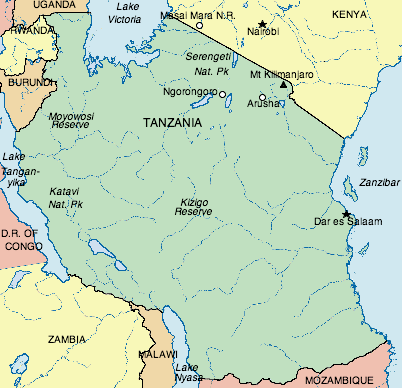Stone Town Zanzibar

May 11-15 2002 City of Stone Town Island of Zanzibar
The tropical island of Zanzibar has a more cosmopolitan and warm and open ambiance than other African countries we have been in-more like the islands off Thailand. Zanzibar is an island partner in the United Republic of Tanzania. It is made up of Pemba and the Unguja Islands, also known as the Spice Islands, along with about 50 small islands. The official languages are Swahili and English and the population including the Island of Pemba is just under 100,000. The religions are Muslim, Hindu, Christian and Traditional Beliefs. Per Capita yearly income is U.S. $190.
Stone Town, the capital, is often the first stop for travelers. After getting off the three-hour ferry from Dar es Salaam, Bob and I chose the Baghani House Hotel, with a nice quiet room with a real air conditioner and full breakfast owned by a friendly local family. That evening we were so tired we missed a big party at the African House Bar and Restaurant commemorating the death of Bob Marley who is revered in Tanzania for his peacemaking role between Tanzania and other African countries (and other) efforts. The next day the other truck riders went on a Spice Tour and continued to the northern beaches to work on their tans and do some fishing while Bob and I stayed in exotic Stone Town to cool our heels and rest after enduring the noise and charcoal cooking smoke of Dar.
The tropical island of Zanzibar has a more cosmopolitan and warm and open ambiance than other African towns we have been in-more like the islands off Thailand. The official languages are Swahili and English and the population including the Island of Pemba is just under 100,000. Zanzibar is an island
partner in the United Republic of Tanzania. It is made up of Pemba and the Unguja Islands, also known as the Spice Islands, along with about 50 small islands. The religions are Muslim, Hindu, Christian and Traditional Beliefs. Per Capita yearly income is U.S. $190.
Stone Town retains the atmospheric trappings of urban life in Muslim cities but hews to a much looser interpretation of Islam than many places in the Middle East. So while calls to prayer regularly resound through the streets, bars and restaurants serve alcohol with little restraint. Leaving the hotel we instantly found ourselves swept into the decaying opulence of the city. From the narrow passageways we ducked into the inner courtyards of old manors, pastel paint peeling from the walls.
What lends Stone Town its charm are the remnants of empire, all piled atop one another and inflected by the native Swahili culture. The Persians were among the first foreigners to settle here alongside the indigenous people. The island was colonized by the Portuguese starting in 1503, and brought under the control of Oman in 1698. The sultan of Oman eventually moved the seat of his kingdom to Zanzibar, which resulted in an artistic renaissance in Stone Town, with Arabic influence becoming much more overt in the designs of manors and palaces. In the late 19th century, the British Empire annexed the island, only to have it gain independence decades later, before coming under the rule of the government of mainland Tanzania.
The shadow of the Arabian peninsula, just across the Indian Ocean, falls everywhere in Stone Town. We made our way through the twisting streets, marveling at the thick wooden double doors with their arabesque carved lintels and large brass studs. One narrow alleyway led to another, with branches veering off in all directions and plenty of dead ends. There were groups of men in white robes and skullcaps playing pool in small cafes, and cramped shops selling everything from spices to television sets to long rolls of multihued cloth. It had the same feel as Cairo – the urban design of Zanzibar is the same as the one imprinted all over the Islamic world.
Tags: African Continent, Best Places, Boats, Russian Federation, Stone Town, Tanzania, Truck, Zanzibar

